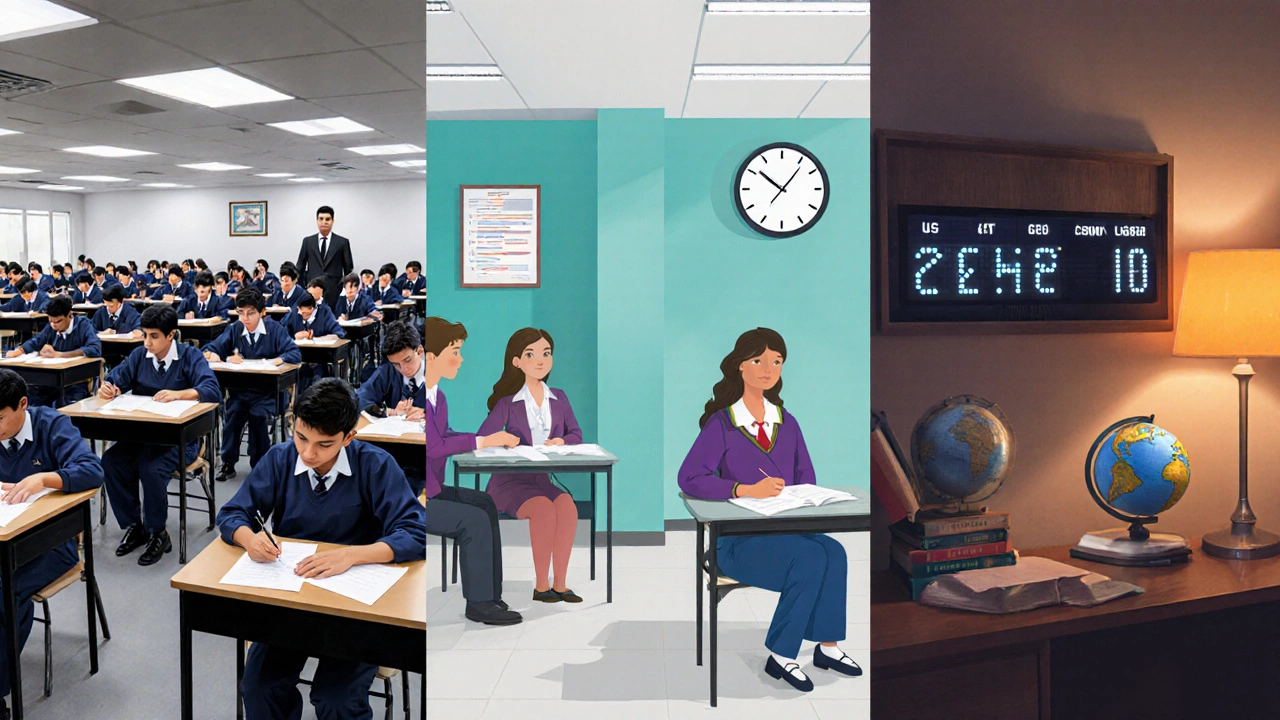Scholarship exam is a standardized test that serves as a gateway to merit‑based financial aid for higher education. Schools, governments, and private foundations use the scores to decide who gets money, so picking the right exam can change the cost of a degree dramatically.
Key Takeaways
- Choose an exam that aligns with your study field and where you plan to apply.
- High‑scoring exams like the SAT, JEE Advanced, and KVPY often unlock the largest scholarship pots.
- Eligibility rules, application windows, and exam frequency differ widely - plan ahead.
- Combine strong test performance with a solid personal statement for best results.
What Exactly Is a Scholarship Exam?
Unlike admission tests that simply decide if you get a seat, a scholarship exam is built to measure academic excellence, talent, or potential. The score is then matched against a pre‑set funding tier. In many countries, the government or a private body announces a specific exam solely for scholarship distribution.
Top Scholarship Exams Around the World
Below are the most widely recognized exams that directly award or qualify you for scholarships. Each one has its own focus, eligibility, and funding level.
KVPY (India)
KVPY - Kishore Vaigyanik Protsahan Yojana - targets students showing exceptional aptitude in science and research. Winners receive a stipend of up to INR 5,000 per month and a chance to sit for prestigious IIT‑JEE scholarships.
NTSE (India)
National Talent Search Examination is a government‑run test for Class 10 students. Top scorers get a lump‑sum scholarship of up to INR 12,000 per year for the entire undergraduate program.
JEE Advanced (India)
While primarily an admission test for IITs, JEE Advanced scores are also used by the Ministry of Education to allocate the "Institute Merit Scholarship" - up to INR 30,000 per semester for top rankers.
NEET (India)
National Eligibility cum Entrance Test for medical courses. The All India Institute of Medical Sciences (AIIMS) offers scholarship waivers of up to 50 % of tuition for the highest‑scoring NEET candidates.
SAT (USA)
The Scholastic Assessment Test is still used by many US colleges to award merit scholarships. The "National Scholarship Test" program can give up to $5,000 per year to students scoring 1500 +.
ACT (USA)
Similar to the SAT, the ACT fuels scholarship pools such as the "ACT Scholarship Program" - up to $2,500 for scores above 32.
GRE (Global)
Graduate Record Examination scores are often a prerequisite for graduate‑level funding. The "GRE Merit Scholarship" offered by many universities can cover full tuition for scores above 330.
GMAT (Global)
Business school applicants use the GMAT to unlock scholarships like the "GMAT Excellence Award," worth up to $10,000 for a 760+ score.
IELTS / TOEFL (International)
English‑proficiency exams themselves rarely grant money, but they are required for many overseas scholarship bundles. For example, the "Commonwealth Scholarship" demands a minimum IELTS 7.0 and provides full tuition plus a living stipend.
Chevening (UK)
The UK government’s Chevening program requires a minimum IELTS 6.5 and a strong academic record - often verified by a university‑level exam. Recipients receive a full‑cost scholarship for a one‑year Master’s.
Fulbright (USA)
Fulbright grants are tied to academic performance and standardized test scores such as the GRE or GMAT, offering up to $30,000 per year for graduate study.
DAAD (Germany)
The German Academic Exchange Service looks at TestDaF or DSH scores (German language exams) together with university grades. Successful applicants receive a full‑tuition waiver and monthly stipend.

How to Pick the Right Exam for Your Scholarship Goal
- Identify your target destination or institution. A US college will value SAT/ACT, while an Indian engineering aspirant should focus on JEE Advanced or KVPY.
- Match the exam to your field of study. Medical scholarships lean on NEET, business scholarships on GMAT, research scholarships on GRE or KVPY.
- Check eligibility windows. Some exams (like NTSE) are only open to specific grades; others run multiple times a year.
- Consider the scholarship amount. Higher funding usually comes with tougher cut‑offs. Decide if you’re aiming for a full ride or a partial boost.
- Assess preparation resources. Exams with abundant coaching centers and free online material (SAT, JEE) are easier to crack.
Comparison of the Most Popular Scholarship Exams
| Exam | Primary Field | Eligibility | Max Scholarship Value | Frequency | Best For |
|---|---|---|---|---|---|
| KVPY | Science & Research | Class 11‑12 (STEM) | ₹5,000 / month | Annual | Young researchers in India |
| NTSE | General Academic | Class 10 | ₹12,000 / year | Annual | High‑school talent seekers |
| JEE Advanced | Engineering | Top 2.5% of JEE Main | ₹30,000 / semester | Once a year | Future IIT engineers |
| NEET | Medical | Class 12 (Science) | 50 % tuition waiver (AIIMS) | Once a year | Medical aspirants in India |
| SAT | Undergrad (US) | High‑school seniors | $5,000 / year | 7 times/yr | US college applicants |
| ACT | Undergrad (US) | High‑school seniors | $2,500 / year | 6 times/yr | US college applicants (alternative) |
| GRE | Graduate (Global) | Undergrad degree | Full tuition (varies) | 3 times/yr | Master’s/PhD candidates |
| GMAT | Business School | Undergrad degree | $10,000 | Continuous | MBA hopefuls |
Practical Tips to Maximize Your Scholarship Chances
- Start early. Many exams require a year of preparation; early prep gives you the edge to score higher.
- Leverage free resources. Official test portals, past papers, and MOOCs often provide high‑quality material at no cost.
- Take mock tests under timed conditions. This builds stamina and highlights weak spots.
- Pair a strong score with a compelling essay. Scholarship committees look for personality, not just numbers.
- Keep an eye on deadlines. Missing the application window nullifies even the best score.

Common Pitfalls to Avoid
Even brilliant students can lose out on funding by making simple mistakes.
- Assuming a high score automatically guarantees a scholarship - most programs need a separate application.
- Ignoring regional eligibility - many Indian exams reserve seats for specific states.
- Neglecting language requirements - overseas scholarships often require IELTS/TOEFL alongside subject exams.
- Submitting incomplete paperwork - double‑check transcripts, recommendation letters, and ID copies.
Next Steps After Choosing Your Exam
Once you’ve zeroed in on the exam that fits your career plan, follow this quick checklist:
- Register on the official exam website (pay fees, choose a test center).
- Download the official syllabus and mark the topics you’re weak on.
- Create a 12‑week study calendar with weekly goals.
- Join a study group or forum for peer support (e.g., Reddit r/Scholarships).
- Plan your scholarship application timeline - most deadlines are 2‑3 months after exam results.
Frequently Asked Questions
Which exam offers the highest total scholarship amount?
For undergraduate study in the US, the SAT combined with the National Scholarship Test can cover up to $5,000 per year. In India, JEE Advanced top‑rankers can receive up to ₹30,000 per semester, which often adds up to a full‑ride when combined with institute‑specific scholarships.
Can I apply for multiple scholarships with the same exam score?
Yes. Most scholarships treat your exam score as a credential, not an exclusive offer. You can submit the same SAT or GRE score to several funding programs, provided you meet each program’s additional criteria.
Do scholarship exams have age limits?
Generally, no strict age caps, but eligibility is tied to education level. For example, NTSE is only for Class 10 students, while the GRE is for anyone with an undergraduate degree regardless of age.
How far in advance should I start preparing?
Aim for at least 6‑12 months of focused study. High‑stakes exams like JEE Advanced or the GRE often require intensive preparation to break into the top scoring brackets that attract scholarships.
Are there free scholarship exam prep resources?
Absolutely. Official test websites offer sample questions, Khan Academy partners with the College Board for free SAT practice, and the National Science Talent Search provides past KVPY papers online.
